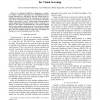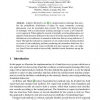688 search results - page 40 / 138 » Using reinforcement learning to adapt an imitation task |
IJCAI
2007
13 years 9 months ago
2007
We introduce an approach to autonomously creating state space abstractions for an online reinforcement learning agent using a relational representation. Our approach uses a tree-b...
ICRA
2009
IEEE
14 years 2 months ago
2009
IEEE
Abstract— Continuous action sets are used in many reinforcement learning (RL) applications in robot control since the control input is continuous. However, discrete action sets a...
ATAL
2005
Springer
14 years 1 months ago
2005
Springer
Reinforcement learning problems are commonly tackled with temporal difference methods, which use dynamic programming and statistical sampling to estimate the long-term value of ta...
ICRA
2009
IEEE
14 years 2 months ago
2009
IEEE
— To address the difficulty of designing a controller for complex visual-servoing tasks, two learning-based uncalibrated approaches are introduced. The first method starts by b...
AI
2006
Springer
13 years 11 months ago
2006
Springer
Abstract. Adaptive Benford's Law [1] is a digital analysis technique that specifies the probabilistic distribution of digits for many commonly occurring phenomena, even for in...


